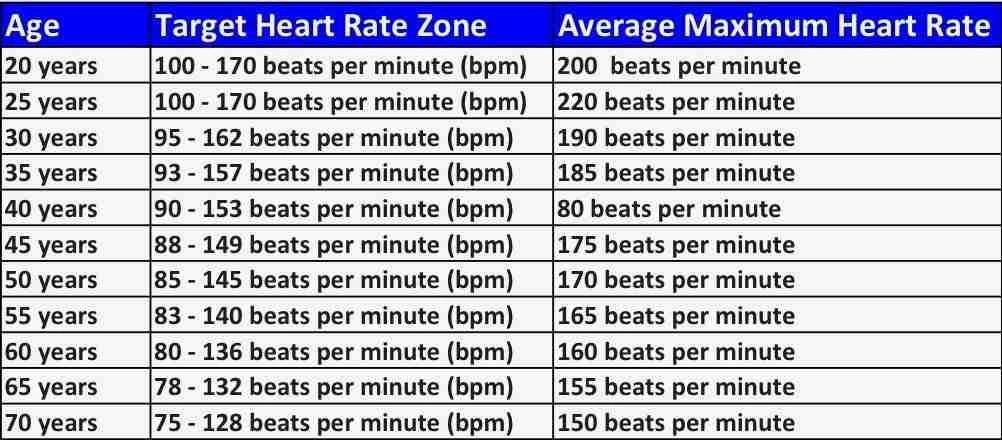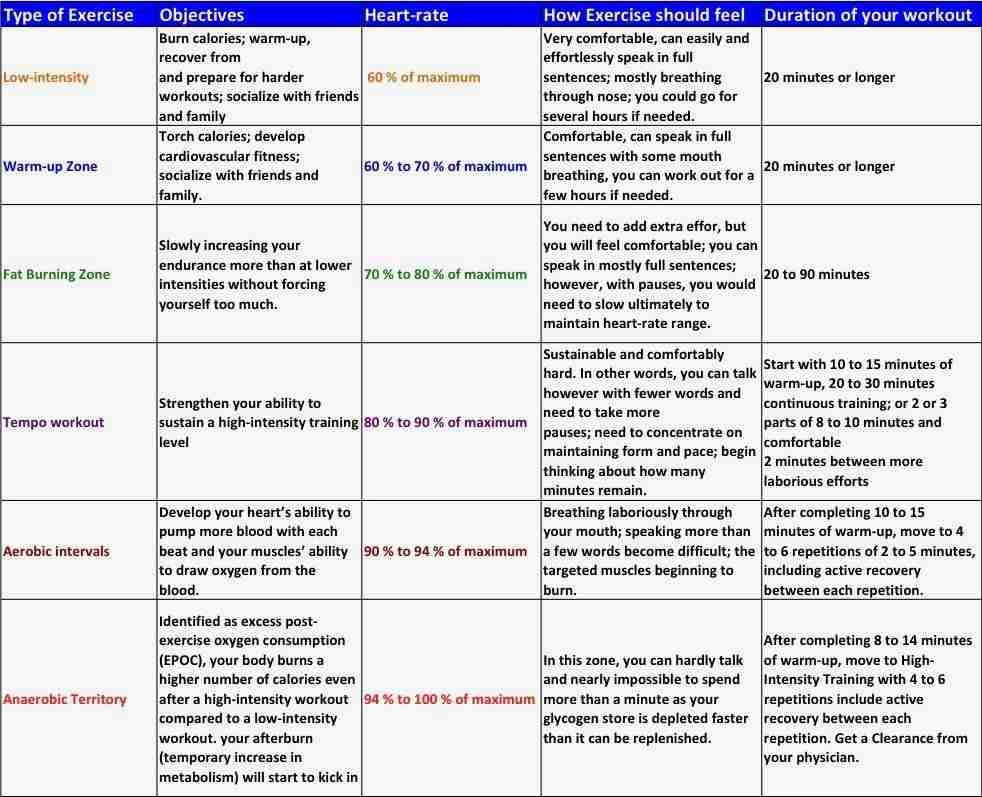
Whether you are performing fat-burning cardio for your health, to stay fit, or lose weight, it is essential to work at a certain level of intensity. Your fat-burning heart rate is a method of determining your exercise intensity. Understanding your fat-burning heart rate can help you reach your weight loss and fitness goals faster.
When you exercise in your fat-burning heart rate zone, your body uses fat stores for energy instead of using essential sugars and carbohydrates. As a result, this will lead to fat loss.
According to the Centers for Disease Control and Prevention, your fat-burning heart rate occurs between 64% and 76% of your maximum heart rate for moderate-intensity physical activity.
Your maximum heart rate means the maximum number of times your heart must beat during activity.
Table of Contents
What Is Your Fat Burning Heart Rate?
When you hit your fat burning heart rate, your body starts burning more stored fat than sugar and other carbohydrates. If your fat burning heart rate is too high, you are going too hard, and try slowing down. If it is too low, you may want to push yourself to exercise a little harder, particularly when you are aiming to lose weight.
If you are a beginner looking to start, aim for the lower range of your target zone (64 percent) and gradually build up. With time, you will be able to train comfortably at up to 93 percent of your maximum heart rate.
Generally, the higher the heart rate, the more fat the body torches compared with other calorie sources, such as carbohydrates.
In a 2016 study, researchers observed that wearable activity trackers accurately measure heart rate during walking and running activities.
How To Find Your Fat Burning Zone?
You can measure your maximum heart rate based on your age for moderate-intensity physical activity. To estimate your maximum, subtract your age from 220. For instance, if you are a 30-year-old, your maximum heart rate would be estimated as 220 – 30 years = 190 beats per minute (bpm). The 64% and 76% levels would be:
- 64% level: 190 x 0.64 = 121.6 bpm, and
- 76% level: 1900 x 0.76 = 144.4 bpm
This example shows that moderate-intensity physical activity for a 30-year-old will need that the heart rate stays between 121.6 and 144.4 bpm during physical activity.
For High-intensity physical activity, your target heart rate should be between 77% and 93% of your maximum heart rate. To figure out this range, try to follow the same formula. For instance, as a 30-year-old, your estimated maximum heart rate would be calculated as 220 – 30 years = 190 beats per minute (bpm). The 77% and 93% levels would be:
- 77% level: 190 x 0.77 = 146.3 bpm, and
- 93% level: 190 x 0.93 = 176.7 bpm
This example shows that in vigorous-intensity physical activity, a 30-year-old will want the heart rate to remain between 146.3 and 176.7 bpm during physical activity.
What Is Your Heart-Rate Zone?
The heart rate zone represents the percentages of your maximum heart rate; it can help determine the intensity of your exercise or activity.
What should your heart rate be when exercising, and how can you track it? Learn to keep your heart rate zone in the target training zone, whether you want to burn fat and lose weight or maximize your workouts.
There is a simple way to know if you are doing too much or not enough when you exercise.
Understanding your heart rate (or pulse) allows you to track your health and fitness level, whether you are a beginner to workout or an elite athlete.
How To Find Your Heart Rate
An individual’s heart rate is usually a good indicator of the intensity of their training or activity. When you are sitting or lying down, your heart rate is usually 60–100 beats per minute, also known as the resting heart rate.
When you work out, your heart rate starts to increase. Your maximum heart rate is the highest heart rate you can safely complete, often during high-intensity workouts.
Most individuals working out at this intensity will have shorter exercises because it is hard to maintain for a long time.
Now that you know your fat-burning heart rate, you can monitor your heart rate to ensure you are in the zone. As you work out, regularly check your heart rate. A wearable activity tracker makes it super easy, but if you don’t use one, you can also find it manually by taking your pulse on the inside of your wrist.

The Heart Rate Training Zones
When you exercise at intensities higher than 70 percent of your max, your body uses carbohydrates as the primary fuel source.
Even though you are not burning fat, you are burning lots of calories. Performing exercise programs such as HIIT (high-intensity interval training) and Tabata (a variety of HIIT) will significantly impact calories burned during and after your workout.
Start with intervals; for instance, you can go hard for one minute, recover for one minute and repeat. As you become proficient, double the number of minutes spent on the intense portion and lowered the number of times on recovery.
Exercising with a heart rate monitor helps you to measure the specific zones in which your body is and how your body benefits from various intensities of exercise. In a 2016 study, researchers observed that wearable activity trackers accurately measure heart rate during walking and running activities.

What Is The Difference Between Fat Burning Zone And Cardio Zone?
You might have already noticed the “fat-burning zone” and “cardio zone” consoles of treadmills, ellipticals, and bikes the last time you were at the gym. The main difference between these concepts is the number of calories burned during your workout versus the amount of fat utilized.
The quantity of calories you burn is directly linked to exercise intensity. The body uses fat as the primary fuel source during lower-intensity workouts. About 60 percent of the calories torched come from fat, which has given birth to the fat-burning zone notion. For overall fat loss, the most critical difference is the difference between the number of calories you consume and the number of calories you burn.
According to the American Heart Association, your target heart rate usually ranges from 50 to 70 percent of your maximum heart rate states. If you work out within the fat-burning zone, your heart rate stays in the lower end of the range, not surpassing 70 percent. To exercise in the cardio zone, the intensity of your training must increase, resulting in a high heart rate.
A high-intensity workout produces several benefits of burning total calories efficiently during and after exercising and keeping your heart healthy. But if you prefer a low-intensity workout, you should devote more time to burning the same amount of calories.
The fat-burning and cardio zones can help you reach your weight loss goals. Ironically enough, with its higher intensities, the cardio zone will burn more calories in a shorter duration. To lose weight, it matters little whether the calories burned during exercise come from fat or carbohydrates. Instead, try to focus on continuously challenging yourself.
What Is Your Resting Heart Rate?
Your resting heart rate represents the number of times your heart beats per minute when you are at rest. A recommended way to check your resting heart rate is in the morning after you have had a good night’s sleep before you get out of bed. For most people, the heart beats between 60 and 100 times a minute while at rest.
Remember, when it comes to resting heart rate, lower is better. It usually indicates your heart muscle is in better condition and does not have to work as hard to keep a steady beat.
Studies have observed that a higher resting heart rate is a risk factor for mortality.
Fat-Burning Zone Exercises
The fat-burning zone is the idea that the body burns more fat at lower-intensity aerobic training than at higher intensities. Actually, the body burns a more significant percentage of fat at lower intensities than at higher intensities.
For instance, at lower intensities, the body may burn 50 percent of the calories from fat, while it may only burn 35 percent at higher intensities. However, at higher intensities, you burn way more total calories—and more fat calories overall—than you do at lower intensities.
Activities such as walking and cycling with little resistance cause your heart rate to stay in the fat-burning zone. Because the intensity of these kinds of workouts is low, you must train longer to burn the same calories compared to a higher-intensity workout. Individuals who are significantly overweight should start with low-intensity exercises to develop an aerobic base before proceeding to high-intensity training.
This idea has led many to think that hitting and staying in the fat-burning heart rate zone is the perfect way to burn fat and lose weight.
How To Choose the Perfect Workout For Your Fat-Burning and Weight Loss Goals?
Choosing an exercise and intensity level to reach your fat-burning zone depends on your fitness level. If you are an elite runner, you will need to run faster to reach your fat-burning zone compared to a beginner runner.
Here are a few suggestions depending on your fitness level.
For Beginners
When performing an exercise for the first time, the National Heart, Lung, and Blood Institute suggests starting slowly and progressively increasing the intensity to prevent injuries.
Many daily activities favor low heart rates and fat-burning opportunities. For instance:
- You can park your car at the back of the parking lot and walk to your office or home.
- Or you can leave your car and ride a bike to shopping or meet friends instead of driving.
- While walking your dog, instead of simply tossing a ball, try to walk and actively play with your dog.
- Instead of the elevator, take the stairs. A research of 14 people in the journal PLoS One observed that although the activity of climbing two steps burns more energy than taking a single step, climbing a staircase one step at a time burns a higher number of calories.
- Try adding walking to your daily routine; studies found that walking is one of the single health behavior that can decrease rates of chronic disease and improve your health.
- Try variations of walking. For instance, you can try walking on routes with hills or slight inclines to boost your walk’s intensity and burn even more calories. A study observed that recreational hill walking has tremendous benefits for health.
For Runners
All types of runs can keep you in the fat-burning zone for your entire workout. A few things to remember:
- Few apps can help track your heart rate and maximize your runs and workouts. This complete list of 36 Best Running Apps For Beginners and Elite is a great start.
- Start slow and keep your pace steady enough to stay in your target heart-rate zone (60–70% of your maximum heart rate). The beginning can be difficult, but you can start by setting SMART Running Goals and learning to accomplish your running goals to achieve your weight loss and fitness goals.
- Consider starting with brisk walks at first — mainly if you are new to running. As your fitness level builds, you can slowly switch into steady runs without getting out of the fat-burning zone.
- Check out these helpful running for weight loss tips for beginners.
- Aim to complete a long, slow, and steady distance run about 3–5 times per week.
- Do not extend your total weekly mileage by more than 10% each week to help avoid the risk of an overuse injury.
- Motivation is key in pursuing and achieving your weight loss and fitness. Read this article, 16 surefire ways how to motivate yourself to run regularly.
For At-Home Workout
- Experts from the Centers for Disease Control and Prevention (CDC) observed that physical activity could improve our health. Men and women who are physically active live longer and have lower risks for heart disease, stroke, type 2 diabetes, depression, and some cancers. However, it is essential how to exercise properly at home.
- In the digital age, the gym comes to us through at-home workout and training apps using videos you can stream on your phone, computer, tablet, or TV whenever it is best for you.
- Choose exercises that target the most important muscles of your body. Start with these 40 fat-burning exercises that are proven to work backed by science.
- When it comes to choosing exercises to lose weight and burn fat, you want to select smart, efficient exercises that burn massive calories, activate your metabolism, and build muscle. These 32 exercises to lose belly fat for men and women will support your weight loss and fitness goals.
For the Gym Lovers
- Do three cardio workouts for an equal amount of time — 15 minutes on the treadmill, 15 minutes on the rowing machine, and 15 minutes on the elliptical.
- Perform this workout 4–5 times per week, and mix up various types of cardio exercises to keep things enjoyable and exciting.
- Try these 40 fat burning exercises that are proven to work backed by science.
- Try Jump rope – jumping rope for about 15 – 20 minutes to warm up during your workouts.
Habits to Maximize Your Fat-Burning Zone
- Become active. It is a known fact that physical activity burns calories and strengthens muscles. It is essential to increase your activity levels to burn fat and get lean. You can start by walking, playing a sport, or exercising at home or the gym. The World Health Organization recommends at least 150 minutes of moderate-intensity aerobic physical activity during the week or performing at least 75 minutes of vigorous-intensity aerobic physical exercise during the week.
- Stay hydrated – Your workout performance is reduced when you are dehydrated. Proper hydration enables your body to perform at the highest level while improving your ability to burn more calories.
- Add Variety to your exercise routine. Avoid performing repetitive workout routines. Supplement your cardio work with resistance training to develop muscle as you burn fat. Various exercises work different muscle groups across your body. Performing a mixture of workouts and combining them with aerobic exercise can help ensure that your whole body stays fit and healthy.
- Clean up your diet. Sugar-filled beverages such as soda, lemonade, and cocktails can negatively affect your belly fat. Substitute these drinks with hydrating fluids like water. Remove processed foods from your diet; try replacing chips and other snacks with protein-rich nuts and veggies. This change in diet will increase your metabolism, help you feel full, and ultimately stop you from overeating without continually counting calories.
- Commit to quality sleep. Sleep deprivation stimulates appetite and might lower your metabolic rate, which leads to overeating and fewer calories burned. Also, short sleep periods can lead to an increased likelihood of obesity. Try aiming for a high-quality night’s sleep.
Conclusion
The key is, to begin with, what you can manage and slowly build from there. If you are a beginner and just getting started, do not worry too much about how hard you work. Concentrate more on making workouts a habit you can manage regularly.
Committing to quality nutrition, regular exercise, and a high-quality night’s sleep will help you torch stubborn body fat while enjoying all the amazing adventures life offers.
The American Heart Association recommends beginners exercise to aim for 50 percent of their heart rate maximum and slowly raise that rate over a few weeks. Beginning too fast can lead to discouragement, early burnout, or injury. Start slowly at first and focus on making consistent progress.
If weight loss and fat burning are your goals, then regularly exercising, heart rate training, and a nutritious diet are your best bet. You will not only lose weight, but you will also be doing it safely and healthily, and you will be able to keep it off.

